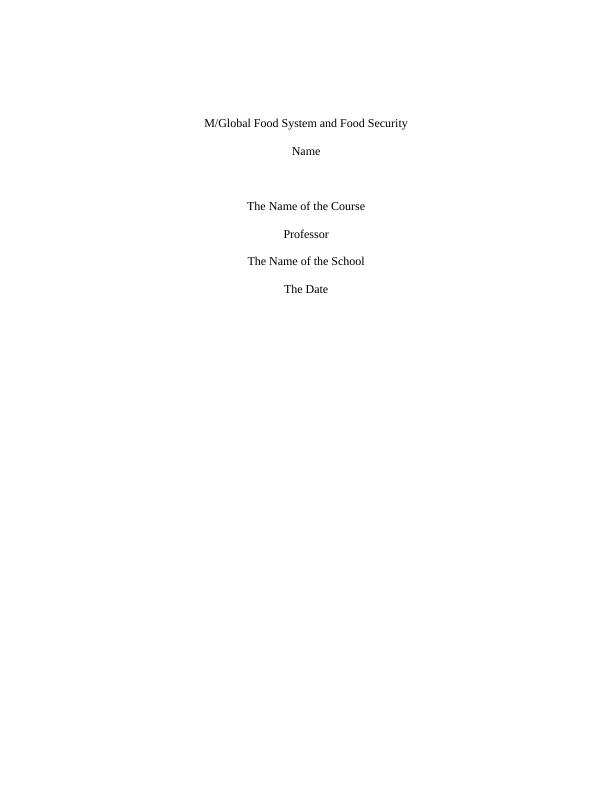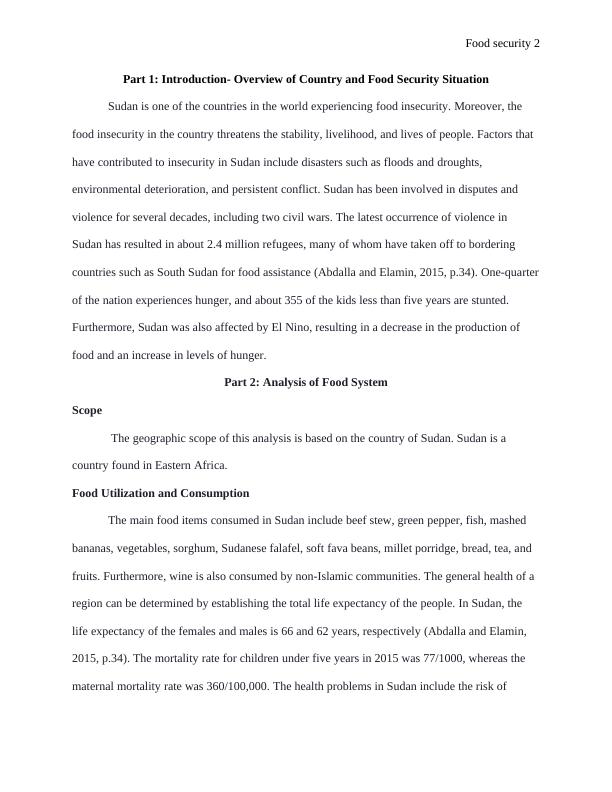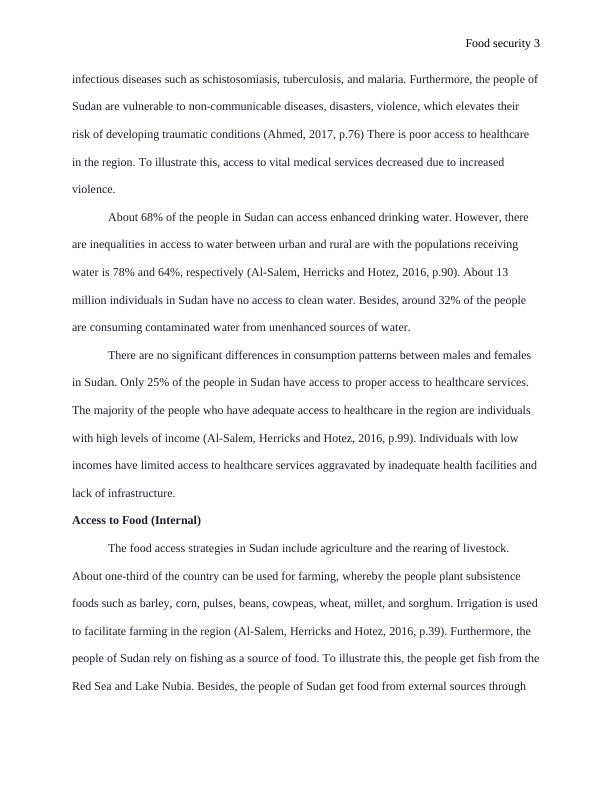Food Security in Sudan: Analysis of Food System and Vulnerability to Shocks
Added on 2022-09-30
13 Pages3860 Words340 Views
M/Global Food System and Food Security
Name
The Name of the Course
Professor
The Name of the School
The Date
Name
The Name of the Course
Professor
The Name of the School
The Date

Food security 2
Part 1: Introduction- Overview of Country and Food Security Situation
Sudan is one of the countries in the world experiencing food insecurity. Moreover, the
food insecurity in the country threatens the stability, livelihood, and lives of people. Factors that
have contributed to insecurity in Sudan include disasters such as floods and droughts,
environmental deterioration, and persistent conflict. Sudan has been involved in disputes and
violence for several decades, including two civil wars. The latest occurrence of violence in
Sudan has resulted in about 2.4 million refugees, many of whom have taken off to bordering
countries such as South Sudan for food assistance (Abdalla and Elamin, 2015, p.34). One-quarter
of the nation experiences hunger, and about 355 of the kids less than five years are stunted.
Furthermore, Sudan was also affected by El Nino, resulting in a decrease in the production of
food and an increase in levels of hunger.
Part 2: Analysis of Food System
Scope
The geographic scope of this analysis is based on the country of Sudan. Sudan is a
country found in Eastern Africa.
Food Utilization and Consumption
The main food items consumed in Sudan include beef stew, green pepper, fish, mashed
bananas, vegetables, sorghum, Sudanese falafel, soft fava beans, millet porridge, bread, tea, and
fruits. Furthermore, wine is also consumed by non-Islamic communities. The general health of a
region can be determined by establishing the total life expectancy of the people. In Sudan, the
life expectancy of the females and males is 66 and 62 years, respectively (Abdalla and Elamin,
2015, p.34). The mortality rate for children under five years in 2015 was 77/1000, whereas the
maternal mortality rate was 360/100,000. The health problems in Sudan include the risk of
Part 1: Introduction- Overview of Country and Food Security Situation
Sudan is one of the countries in the world experiencing food insecurity. Moreover, the
food insecurity in the country threatens the stability, livelihood, and lives of people. Factors that
have contributed to insecurity in Sudan include disasters such as floods and droughts,
environmental deterioration, and persistent conflict. Sudan has been involved in disputes and
violence for several decades, including two civil wars. The latest occurrence of violence in
Sudan has resulted in about 2.4 million refugees, many of whom have taken off to bordering
countries such as South Sudan for food assistance (Abdalla and Elamin, 2015, p.34). One-quarter
of the nation experiences hunger, and about 355 of the kids less than five years are stunted.
Furthermore, Sudan was also affected by El Nino, resulting in a decrease in the production of
food and an increase in levels of hunger.
Part 2: Analysis of Food System
Scope
The geographic scope of this analysis is based on the country of Sudan. Sudan is a
country found in Eastern Africa.
Food Utilization and Consumption
The main food items consumed in Sudan include beef stew, green pepper, fish, mashed
bananas, vegetables, sorghum, Sudanese falafel, soft fava beans, millet porridge, bread, tea, and
fruits. Furthermore, wine is also consumed by non-Islamic communities. The general health of a
region can be determined by establishing the total life expectancy of the people. In Sudan, the
life expectancy of the females and males is 66 and 62 years, respectively (Abdalla and Elamin,
2015, p.34). The mortality rate for children under five years in 2015 was 77/1000, whereas the
maternal mortality rate was 360/100,000. The health problems in Sudan include the risk of

Food security 3
infectious diseases such as schistosomiasis, tuberculosis, and malaria. Furthermore, the people of
Sudan are vulnerable to non-communicable diseases, disasters, violence, which elevates their
risk of developing traumatic conditions (Ahmed, 2017, p.76) There is poor access to healthcare
in the region. To illustrate this, access to vital medical services decreased due to increased
violence.
About 68% of the people in Sudan can access enhanced drinking water. However, there
are inequalities in access to water between urban and rural are with the populations receiving
water is 78% and 64%, respectively (Al-Salem, Herricks and Hotez, 2016, p.90). About 13
million individuals in Sudan have no access to clean water. Besides, around 32% of the people
are consuming contaminated water from unenhanced sources of water.
There are no significant differences in consumption patterns between males and females
in Sudan. Only 25% of the people in Sudan have access to proper access to healthcare services.
The majority of the people who have adequate access to healthcare in the region are individuals
with high levels of income (Al-Salem, Herricks and Hotez, 2016, p.99). Individuals with low
incomes have limited access to healthcare services aggravated by inadequate health facilities and
lack of infrastructure.
Access to Food (Internal)
The food access strategies in Sudan include agriculture and the rearing of livestock.
About one-third of the country can be used for farming, whereby the people plant subsistence
foods such as barley, corn, pulses, beans, cowpeas, wheat, millet, and sorghum. Irrigation is used
to facilitate farming in the region (Al-Salem, Herricks and Hotez, 2016, p.39). Furthermore, the
people of Sudan rely on fishing as a source of food. To illustrate this, the people get fish from the
Red Sea and Lake Nubia. Besides, the people of Sudan get food from external sources through
infectious diseases such as schistosomiasis, tuberculosis, and malaria. Furthermore, the people of
Sudan are vulnerable to non-communicable diseases, disasters, violence, which elevates their
risk of developing traumatic conditions (Ahmed, 2017, p.76) There is poor access to healthcare
in the region. To illustrate this, access to vital medical services decreased due to increased
violence.
About 68% of the people in Sudan can access enhanced drinking water. However, there
are inequalities in access to water between urban and rural are with the populations receiving
water is 78% and 64%, respectively (Al-Salem, Herricks and Hotez, 2016, p.90). About 13
million individuals in Sudan have no access to clean water. Besides, around 32% of the people
are consuming contaminated water from unenhanced sources of water.
There are no significant differences in consumption patterns between males and females
in Sudan. Only 25% of the people in Sudan have access to proper access to healthcare services.
The majority of the people who have adequate access to healthcare in the region are individuals
with high levels of income (Al-Salem, Herricks and Hotez, 2016, p.99). Individuals with low
incomes have limited access to healthcare services aggravated by inadequate health facilities and
lack of infrastructure.
Access to Food (Internal)
The food access strategies in Sudan include agriculture and the rearing of livestock.
About one-third of the country can be used for farming, whereby the people plant subsistence
foods such as barley, corn, pulses, beans, cowpeas, wheat, millet, and sorghum. Irrigation is used
to facilitate farming in the region (Al-Salem, Herricks and Hotez, 2016, p.39). Furthermore, the
people of Sudan rely on fishing as a source of food. To illustrate this, the people get fish from the
Red Sea and Lake Nubia. Besides, the people of Sudan get food from external sources through

Food security 4
importation from countries such as Kenya and Uganda. The importation of food from other
countries has also contributed to food shortage because the supplies are acquired at higher prices.
The people of Sudan have several sources of income. The sources of income include
agricultural production, retailing, and livestock production (Buchanan, 2018, p.61). Additionally,
there are several industries in Sudan that provide people with a source of income. Such industries
include meat processing, sugar production, tanning, furniture, manufacturing of plastics, and
assembly of electronics. Furthermore, the country exports petroleum, which provides income to
many individuals. However, the rate of unemployment in Sudan is relatively high, with the rate
currently being
The majority of people live in poverty. At the national level, the majority of people use
61.4% of their household income to buy food. In rural areas, people use 65.7% of their
household income to purchase food, whereas the percentage is 56.4% in urban areas (Buchanan,
2018, p.64). Also, the majority of people access food from friends, family members, and well-
wishers when they are in need. There are also internally displaced refugees in Sudan who receive
food assistance from the government of Sudan. Besides, there are about 800,000 refugees from
South Sudan who fled to Sudan. However, due to cases of violence and conflicts, food shortage
has continued to be a problem in the region.
Access to Food (External)
The vital food access strategies in Sudan as a whole include agriculture, herding, and
fishing. The country launched an irrigation program to promote farming of subsistence crops
such as sorghum, millet, maize cowpeas, and wheat (Campbell et al., 2016, p.76) Moreover, a
significant percentage of the people in Sudan are cattle herders and depend on the livestock as a
importation from countries such as Kenya and Uganda. The importation of food from other
countries has also contributed to food shortage because the supplies are acquired at higher prices.
The people of Sudan have several sources of income. The sources of income include
agricultural production, retailing, and livestock production (Buchanan, 2018, p.61). Additionally,
there are several industries in Sudan that provide people with a source of income. Such industries
include meat processing, sugar production, tanning, furniture, manufacturing of plastics, and
assembly of electronics. Furthermore, the country exports petroleum, which provides income to
many individuals. However, the rate of unemployment in Sudan is relatively high, with the rate
currently being
The majority of people live in poverty. At the national level, the majority of people use
61.4% of their household income to buy food. In rural areas, people use 65.7% of their
household income to purchase food, whereas the percentage is 56.4% in urban areas (Buchanan,
2018, p.64). Also, the majority of people access food from friends, family members, and well-
wishers when they are in need. There are also internally displaced refugees in Sudan who receive
food assistance from the government of Sudan. Besides, there are about 800,000 refugees from
South Sudan who fled to Sudan. However, due to cases of violence and conflicts, food shortage
has continued to be a problem in the region.
Access to Food (External)
The vital food access strategies in Sudan as a whole include agriculture, herding, and
fishing. The country launched an irrigation program to promote farming of subsistence crops
such as sorghum, millet, maize cowpeas, and wheat (Campbell et al., 2016, p.76) Moreover, a
significant percentage of the people in Sudan are cattle herders and depend on the livestock as a

End of preview
Want to access all the pages? Upload your documents or become a member.